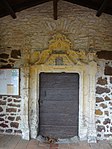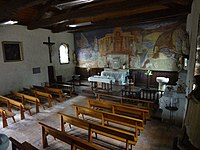Lubbon
|
Lubbon Lucbon |
||
|---|---|---|
|
|
||
| region | Nouvelle-Aquitaine | |
| Department | Country | |
| Arrondissement | Mont-de-Marsan | |
| Canton | Haute Lande Armagnac | |
| Community association | Landes d'Armagnac | |
| Coordinates | 44 ° 6 ′ N , 0 ° 2 ′ W | |
| height | 134-156 m | |
| surface | 47.74 km 2 | |
| Residents | 104 (January 1, 2017) | |
| Population density | 2 inhabitants / km 2 | |
| Post Code | 40240 | |
| INSEE code | 40161 | |
 town hall |
||
Lubbon is a French municipality with 104 inhabitants (at January 1, 2017) in the department of land in the region Nouvelle-Aquitaine (before 2016: Aquitaine ). The municipality belongs to the arrondissement of Mont-de-Marsan and the canton of Haute Lande Armagnac (until 2015: canton of Gabarret ).
The name is Lucbon in the Gascognischen language . It is derived from the Latin locus bonus , meaning “holy forest” or “beautiful forest”.
The inhabitants are called Lubbonais and Lubbonaises .
geography
Lubbon is located approx. 45 km northeast of Mont-de-Marsan in the Gabardan region in the historic province of Gascony on the northeastern border with the neighboring Lot-et-Garonne department .
Lubbon is surrounded by the neighboring communities:
|
Allons (Lot-et-Garonne) Houeillès (Lot-et-Garonne) |
Boussès (Lot-et-Garonne) | |
| Losse |

|
Arx |
| Rimbez-et-Baudiets | Baudignan |
Lubbon lies in the catchment area of the Garonne River .
One of its tributaries, the Ciron , rises on the territory of the municipality, as do its tributaries,
- the Ruisseau de Perrucq,
- the Ruisseau du Bole,
- the Ruisseau du Pic,
- the glabias and its tributary,
- the Ruisseau de Guilhem, and
- the Ruisseau l'Escourre.
The Rumbez, a tributary of the Gélise , also has its source in Lubbon.
history
Remains of Roman roads and funeral urns are evidence of settlement since Gallo-Roman times . The presence of nuns from the Order of Fontevrault in the village since 1253 is documented in the writings. In 1321 the village was under the protection of the English king, who instructed Bernard de Lubbon to leave the nuns in peace. The medieval life in Lubbon was marked by the conflict between the English king and the French crown for the possession of the county of Gabardan in which the municipality is located. In 1345 Arnaud de Lubbon pledged his allegiance to the English king. It was not until 1696 that Lubbon officially became part of the French kingdom. After the Hundred Years War , fighting between Protestant and Catholic troops rocked the region. All villages felt the effects of these events, especially in the architecture and fortifications of their churches. The 17th century brought a period of political, economic and social calm. In 1729 the parish was subordinate to the Archdiocese of Sos and counted 236 believers. The Peyrebère family ruled Lubbon for two centuries. Joseph Peyrebère was an MP in 1790.
Population development
After the beginning of the recordings, the population fluctuated between the first half and the end of the 19th century between 420 and 470. In the following period the size of the community decreased with short recovery phases until the 1980s to less than 100 inhabitants, before a moderate one at the turn of the millennium Growth began.
| year | 1962 | 1968 | 1975 | 1982 | 1990 | 1999 | 2006 | 2010 | 2017 |
|---|---|---|---|---|---|---|---|---|---|
| Residents | 164 | 125 | 119 | 95 | 99 | 95 | 104 | 106 | 104 |
Attractions
Parish Church of Saint-Pierre
The church consecrated to the Apostle Peter was mentioned around 1270 in the Recognitiones feodorum in Aquitania of the Archdiocese, also under the name "ecclesia de luco bono". In August 1253 it was donated by the Bonel de la Serre family to the Priory de Paravis of the Order of Fontevrault in Feugarolles in what is now the Lot-et-Garonne department . This dependency lasted until the 18th century. In 1492, the parish of Saint-Pierre de Haut-Lubbon expanded to include the parish of Saint-Martin de Bas-Lubbon, whose church had been destroyed in the Hundred Years War. At this time the parish church was rebuilt. The western entrance portal was created in the late Gothic style, as were the tracery windows in the southern outer wall of the nave . The choir that once extended the nave disappeared at an unknown date, while a sacristy was built on the northeast side in 1626 . The east wall of the nave was decorated inside with a fresco in 1941 and 1942 by the artist Marie Baranger . In 1990 the building was completely restored. The church is made of Garluche, the ferrous sandstone of the Landes, mixed with limestone . The nave is supported in the south by three triangular buttresses . In the west, a small open vestibule is built in front of the facade of the building, which is closed at the top with a triangular bell gable .
A relief that used to be embedded in the wall to the left of the entrance portal was placed in the nave after 2004. The original function remains a mystery. It is a bust of a man. The head is mutilated, presumably a ring surrounds his body. Both hands are raised and hold an object, the right a bracelet or necklace. The object in the left hand is more difficult to identify. It can be a small snake with a spherical head or a whip. Due to the iconography , a careful dating to the end of antiquity can be made. Otherwise, the decor and furnishings of the church come from elements from the 17th to the end of the 20th century. A bell, a baptismal font and an oil painting depicting the Entombment of Christ, a copy of a lost painting by Joseph Heintz the Elder (1564–1609), date from the 17th century . The stone holy water font dates from the 18th century. The two altars were erected at a later date, the classical main altar around 1850, the neo-Gothic side altar dedicated to the Virgin Mary towards the end of the 19th century. The two statues were created in the same epoch with the representation of Mary with baby Jesus and the archangel Michael in the scene in which he defeats the devil. The fresco, which the artist Marie Baranger (1902–2003) created, shows three scenes against the common landscape background. On the left is the biblical story in which Jesus Christ and Peter walk across the water. In the middle, above the main altar, Peter sits on a throne giving a blessing, holding the keys, in the background St. Peter's Basilica . The right side shows three young priests dressed in cassocks and a canon , undoubtedly a representation of Pastor Salvat, who looked after the community and commissioned the creation of the fresco. In 1990, on the occasion of a restoration of the church, new glass windows by the glass painter Brigitte Nogaro from Saint-Paul-lès-Dax were installed.
Statue of Joan of Arc in the open porch
Peyrebère Castle
The Peyrebère family settled in Lubbon in 1720. François Peyrebère was a merchant and innkeeper and bought the land that his descendants worked. When the castle was built, the family owned almost all of the land in the village. Albert Peyrebère was married to the daughter of Adhémar Guilloutet, a well-known personality from Parleboscq . This urged his son-in-law to build a castle to meet the French Emperor Napoleon III. to receive who should appoint him a count. The Franco-Prussian War and the overthrow of the Empire prevented this wish and construction work was initially suspended for three years. The call to the local architect Alexandre Ozanne finally led to the completion of the construction project. The building is surrounded by four towers of different shapes, which are crowned with tent roofs and weir core. A balcony is decorated with an eyelash and pegs . The castle is privately owned and is not open to the public.
Economy and Infrastructure

Total = 23
traffic
Lubbon can be reached via the Routes départementales 377, 665 and 933N, the former Route nationale 133 .
Web links
Individual evidence
- ↑ Lubbon ( fr ) Gasconha.com. Retrieved July 7, 2018.
- ↑ a b Lubbon ( fr ) Conseil régional d'Aquitaine. Archived from the original on March 19, 2017. Retrieved July 7, 2018.
- ↑ Landes ( fr ) habitants.fr. Retrieved July 7, 2018.
- ^ Ma commune: Lubbon ( fr ) Système d'Information sur l'Eau du Bassin Adour Garonne. Retrieved July 7, 2018.
- ↑ Notice Communale Lubbon ( fr ) EHESS . Retrieved July 7, 2018.
- ↑ Populations légales 2006 Commune de Lubbon (40161) ( fr ) INSEE . Retrieved July 7, 2018.
- ↑ Populations légales 2015 Commune de Lubbon (40161) ( fr ) INSEE . Retrieved July 7, 2018.
- ↑ église paroissiale Saint-Pierre ( fr ) Ministry of Culture and Communication . Retrieved July 7, 2018.
- ^ Le mobilier de l'église paroissiale Saint-Pierre ( fr ) Ministry of Culture and Communication . Retrieved July 7, 2018.
- ↑ relief ( fr ) Ministry of Culture and Communication . Retrieved July 7, 2018.
- ↑ peinture monumentale: Saint Pierre bénissant avec le pape Pie XII et Mgr Mathieu, le Christ et saint Pierre sur les eaux, apparition de Lourdes ( fr ) Ministry of Culture and Communication . Retrieved July 7, 2018.
- ↑ Château Peyrebère ( fr ) chateau-fort-manoir-chateau.eu. Retrieved July 7, 2018.
- ↑ Caractéristiques des établissements en 2015 Commune de Lubbon (40161) ( fr ) INSEE . Retrieved July 7, 2018.











